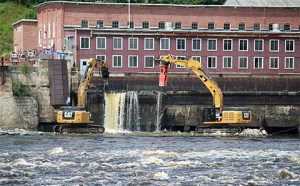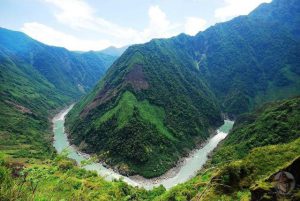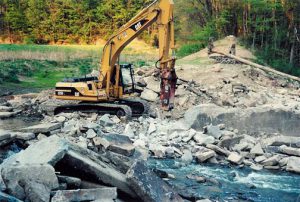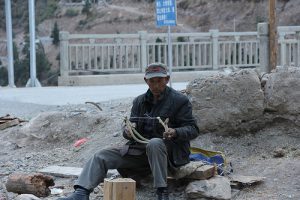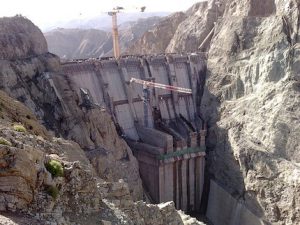The development of China’s rivers has already gone too far, says a new report – if they aren’t protected by the end of the 13th Five Year Plan (FYP), in 2020, it will be too late.
Nineteen environmental groups, including Friends of Nature and the Institute for Public & Environmental Affairs, have published a report re-examining the damage done to China’s rivers by the last decade of hydropower development.
The NGOs are deeply worried that both the Xiaonanhai dam, which will damage the last habitat for rare fish on the upper Yangtze, and the Nu River cascade of dams halted by Wen Jiabao, are now included in state plans.
Hydropower is being developed intensively as a substitute for fossil fuels, in order to cut down on greenhouse gas emissions, but it is spurring energy-hungry and polluting industries to develop in south-western China.
Li Bo, former secretary of Friends of Nature, said that electricity is cheap in the south-west and as many hydropower plants aren’t connected to the grid, the electricity produced has to be consumed locally. All that affordable power allows local governments to attract energy-hungry industries.
Worse, the dams cannot generate power during the dry season, but the factories keep working. Electricity cannot be drawn from elsewhere in western China, as it is needed in the east, and so polluting coal-fired power is used, forming a vicious circle.
For example, in order to ensure a stable supply of at least 10GW to Guangdong and its neighbouring provinces, Guizhou built much more coal-fired generating capacity than hydropower. Sichuan, Guangxi and Yunnan, also in the south-west, are doing the same.
Li added that the last ten or more years has seen serious overcapacity in energy-hungry sectors.
A meaningless approval system
But the existing system still fails to provide for overall limits on hydropower development and there are no substantive environmental impact assessments for dam construction. Li told chinadialogue that one major failing of China’s hydropower development is the lack of overall river-level planning.
Planning for the Yangtze for many years used a Yangtze River Commission document produced in 1991. A revision submitted in 2009 was only passed in 2012. The old document was far out of date: it did not consider the river’s ecology or biodiversity and failed to take into account changes in the area’s social and economic circumstances.
And before the new plan was published there was a rush to get hydropower projects underway. Today China has 80,000 dams built or under construction – half of all the world’s dams. 20,000 of those are generating hydropower. As of 2011 China had 5,200 large (30 metres or more) dams built or under construction.
One important factor in how hydropower has been given free rein in China is a ‘two-track’ environmental approval system.
Hydropower developments happen in two stages. First, water and power is provided to the site, a road built, and the ground levelled. Second, the actual dam is built.
Li explained that once an application for approval for the dam project has been lodged, the project owners can go ahead with the first stage. But this alone can be a huge and damaging undertaking. On completion of the first stage the company could have already spent hundreds of millions of yuan, and badly damaged the local environment.
Diverting the river to allow for dam construction can also be included in that first stage. On the middle reaches of the Jinsha this happened at the Liyuan, Ludila, Longkaokou and Xiluodu dams, all before Environmental Impact Assessment reports (EIA) had been approved. This makes the assessment process meaningless.
And ultimately, the EIA reports are quietly approved, “all out of public view,” Li says. And this is the third problem: a lack of public participation and oversight.
He gives the Shuiluo river, a tributary of the Jinsha close to the Liyuan dam, as an example. In October 2009, during the period for public comment on the EIA, Friends of Nature and other NGOs queried provision of fish reserves if the Liyuan dam was built. The company only replied in November 2010, promising that the Shuiluo would be made a part of the Yangtze fish reserve.
But, Li says, NGO investigations then found that gold mining activity had already made the river unsuitable for use as a reserve. And as far back as 2006 plans for a cascade of 11 dams had been decided upon, with work already underway.
How to turn things around?
The NGOs’ report called for an urgent halt to approvals for preliminary construction, and for river protection legislation to set “red lines”. This would stop some of the environmental damage development currently causes. Also, public participation and hearings during hydropower approvals would help stop arbitrary development.
There are also two economic issues which Li Bo thinks could be used to hold back river development.
First, hydropower companies do not currently pay for environmental losses or restoration. Companies should make profit-and-loss calculations when building a dam, yet in China maintenance, removal and restoration costs are borne almost entirely by the taxpayer.
Li would like to see the United States’ approach used – give the company a license to operate the dam for a certain number of years, during which it will be responsible for all risks. Potential profits would then determine if the dam was built or not, and for how long it would be operated.
Second, the potential of other, non-hydropower, renewable energy sources has been underestimated. According to the report, China has exploitable hydropower resources of between 400 and 600 GW – compared to 2200 GW for solar power, and 700 to 1200 GW for wind power.
Solar and wind power are also developing at incredible speed. Between 2005 and 2012 solar power capacity leapt from 0.7 GW to 3.28 GW; the target for solar power set in the 12th Five Year Plan had to be raised 5 times – from 5 to 40 GW. Jiang Kejuan, board member of the China Energy Research Society, has told Li that even that final target is conservative. Meanwhile windpower capacity jumped from 0.131 to 70 GW, against a 12th FYP target of 100 GW.

